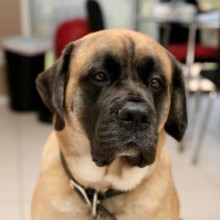Mastiff (English)
Lifestyle Needs

The Mastiff is an extremely large dog both in height and girth who will consume enormous quantities of food. He needs a large house to live in and a large garden to roam in. In addition he should have plenty of exercise. His coat is short and dense, requiring grooming once a week. He is generally a good-natured dog but can be protective of his owner. He is an exceptionally powerful dog and can be difficult to control. He needs a physically strong, dedicated and experienced owner. The Mastiff is not an ideal family dog.
Genetic Diversity
(Known as Coefficient of Inbreeding: 'COI'. It should be as low as possible.)
The UK Kennel Club breed average COI is 13.3% - See 'A Beginners Guide to COI'
Gene Pool Size
(Known as Effective Population Size: 'EPS')
70.5
EPS is a measure of how many individuals are contributing genetically to a breed population. It is a measure of the size of the gene pool in a breed. Lower than 100 is considered critical by conservationists and below 50 brings a breed close to extinction. For more information see the Kennel Club article.
Health and Welfare Problems due to Conformation
(Body shape and physical characteristics)
- The Mastiff’s extreme size and weight could result in unnecessary strain on his joints
- Skin folds around his face and neck could cause skin problems
- Gastric dilatation volvulus (GDV) (Bloat/Torsion. Common in large, deep chested breeds
BVA/KC Health Schemes: www.bva.co.uk/chs
- Hip dysplasia: breed 5 year mean score 15 (parents should be lower)
- Elbow dysplasia: ideally O:O
- Eye disease: Progressive retinal atrophy (PRA) (annual testing)
The Mastiff is one of the high profile breeds designated by the Kennel Club as requiring particular monitoring by reason of visible conditions which may cause health and welfare concerns
Estimated Breeding Values (EBVs) : No EBVs are currently available for this breed
www.thekennelclub.org.uk/about-ebvs
DNA Tests Available
DogWellNet and IPFD Harmonisation of Genetic Testing for Dogs (HGTD)
www.dogwellnet.com/breeds
- Canine Multi-focal Retinopathy 1 (CMR1)
Availability of a DNA test does not mean that it is always necessary or even desirable for breeders to use this test.
Other Breed-Specific Health Screening Schemes
- Bitches under 20 months not to produce a litter
- Bitches over 6 years not to produce a litter
Ask the breeder to show you the certificates for the above tests/screening for both parents. If any of the above tests have not been considered necessary by the breeder (and there may be good reasons), ask her to explain why.
Other Diseases Reported
(For which there are currently no genetic or screening tests for sire or dam)
- Heart disease
- Cranial cruciate ligament rupture
- Panosteitis
- Osteochondrosis – shoulder and stifle
- Cancer: Osteosarcoma; lymphoma
- Ectropion/Entropion
- ‘Cherry Eye’
- Skinfold dermatitis
Ask the breeder about the medical history of the parents, grandparents and great grandparents. Consider carefully whether to purchase a puppy if some of these or other diseases are in the family line.
Ask about the breeder’s policy in cases of serious genetic diseases occurring to your puppy in later life. Good breeders will request to be informed of such events in order to improve future breeding decisions.
You are strongly advised to buy from a breeder who uses (or is prepared to use) the AWF Puppy Contract and Puppy Information Pack (PIP): www.puppycontract.org.uk
The breeder should also be familiar with the CFSG/DBRG Code of Practice for Dog Breeding
Or the Kennel Club’s Assured Breeders Scheme Standard and Guidance:
Standard PDF | Guidance PDF